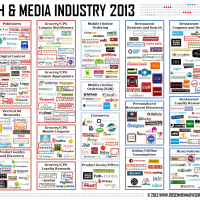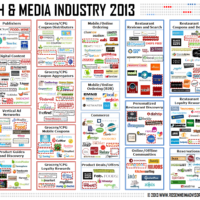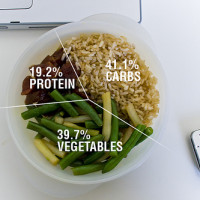Content is king when trying to attract readers and keep them coming back to your site. How do you sustain an audience? Several well-known writers opened up about strategies for keeping their content fresh and relevant for their readers at this year’s TECHMunch NYC event at Astor Center this past Saturday. Emily Cavalier from the popular site Mouth of the Border moderated the panel.
Walk us through the make up of your content. Do you use video, text, data, and/or infographics?
Karen Seiger, author of the book and website Markets of New York City, led off the discussion. She lets her readers know about all the great things she finds at local market events via long and short posts and by featuring a “Pick of the Markets.” She also actively promotes her work via Facebook, Twitter, Foursquare , and Facebook Places. Even she admits, however, “there is only so much time in the day,” so people need to decide what type of outreach works best for them.
Danielle Gould of Food+Tech Connect focuses on interviews and infographics, saying that people love the latter. For Lynn Adriani of Oprah.com, text is their main medium, but they try to vary the writing within that rubric. They will have Q&As, link round-ups, service pieces, and special daily features.
Features, photo galleries, and round-ups are items that Lauren Drell from Mashable says work well. She also highlighted that infographics, Q&As, and news-style posts are good ways to reach out to an audience and that sites need to execute social media well. It’s about how readers can use things that they find online to enrich their lives.
Tell us about changes over the past year. How do you use food or social data in your company?
For Adriani, it is about digesting all the changes that have come in the last year with Twitter, Flickr, Tumblr, and to a lesser degree Facebook. She uses these resources to connect with what is going on in the world and to accumulate data, especially social data, about what is happening right now. She reads the message boards on Chow and Craigslist, but also looks elsewhere to see what non-food bloggers might be talking about. She added that with all this information, we need food writers like Mark Bittman who can make this data accessible and real.
People are increasingly exploring a wider variety of aspects relating to food, said Gould, with companies investing more in this area. Infographics are a way of making understandable the kinds and amount of information that the USDA has available. Drell added that food has become a big topic for Mashable and now has its own feed on curated food list on Twitter.
This is not something that would have been the case a few years ago, she offered, and has been driven by the amount of traffic generated by food topics on social media streams. People are really passionate about the brands they follow, as she discovered when she worked for Luke’s Lobster. This fandom also makes food something that is easy to sell as a product.
For New York, the markets provide a benefit in that they are an incubator for these products, pointed out Seiger. This is going back to an old-school model of testing something out in the physical marketplace. “You know what the new cupcake is?” she asked the audience. “Well, it’s the cupcake,” she replied. When people start talking about the latest “it” ingredient, like bacon showing up in bacon peanut brittle, the next thing you know, it’s at Chelsea Market, on Oprah, etc., she added.
For brands like the Kimchi Taco Truck and the Big Gay Ice Cream Truck, they put their hearts and their marketing efforts into social media. This allows them to promote the people who promote them and their products. As far as market items that she sees becoming popular on the horizon, Seiger suggested raw chocolate, kimchi, and seasonal items like ramp butter.
Lucy’s Greenmarket Report was cited as the go-to guide for following what is in the farmers market. Gould also recommended Real Time Farms, which aggregates food information and links to restaurants and food artisans who are using the produce from these farms. Some of the NYC Greenmarkets also have their own Twitter feeds so that you can get up-to-date tidbits about what is available in the market that day.
There’s a lot of noise out there. How do you go about distinguishing between a fact and a fad and try to write about it?
Seiger said that she looks at the people behind something to see what is there. Going back to the cupcake analogy, she mentioned that after “Sex and the City” with Magnolia Bakery, the cupcake should have been over, right? Now, they’ve become classics and dedicated artisans like Kumquat, Lux Sugar, and Robicellis have taken this on and taken it further. If something seems to her to be corny, cheesy or disingenuous, she gives it some time. After researching the markets and hanging out with local vendors, Seiger added, she can kind of feel, see, and taste what is “it.”
As someone who writes about ethnic eating experiences, Cavalier said that looks at what foods are trending in which countries. The New York Public Library is a good source for research with its vast menu collection, so she doesn’t just take what is in Wikipedia as her sole source of information. Taking this topic a bit further, she raised another point along these lines:
Bloggers have more flexibility or do you feel like you have to stick to a path or do more research?
We do follow trends, stated Adriani, and they can turn around very quickly, like whether whoopie pies are the latest cupcake. That said, however, we have to navigate as bloggers, and you need to establish who you are, your voice, and your take on food. Once you have done that, you can explore a bit, keeping in mind to “stay true to how your food outlook is.”
How do you ease into a conversation about new trends? (if you want to talk about something that you don’t usually do)
Place this in the context of the things that you have done before, replied Adriani. Find a way into the conversation via your previous experiences and writing.
Cavalier offered that she eases into the conversation as she would in any other setting. She writes about ethnic food, but she wanted to do an article about someone who was making stocks completely from scratch using bones from the farmers themselves. So, her angle was to talk about the role that stocks and soups made in that fashion have in traditional cultures.
How have you used crowdsourcing data to build your business?
For Luke’s Lobster, social media was a way to build community and respond to their customers, explained Drell. They would field every complaint and listen to what the conversation was about their lobster rolls as a way to gather feedback without imposing a suggestion card on everyone. As a method of engagement, it allows people to feel a connection to the places where they eat when they can suggest menu items, post pictures, etc. Crowdsourcing is an efficient media and even helped them locate a conference room via a Twitter post.
Does it give scientific polling data to influence business ideas?
Seiger gave the example of Lake Effect Ice Cream in upstate New York, which went out and asked everyone for their favorite flavor. They also used social media as a sales opportunity. When they kept seeing messages that a particular store was out of a specific flavor, the owners approached the store to see if they would like to stock more of that flavor. They were able to change their distribution model to that store based upon crowdsourcing, so it can be a very powerful media.
Tell us how your audience and consumers can better leverage data and have a better experience with food in general?
The USDA has released more data and in cleaner formats said Gould. They will also be putting up information about the farmers markets in the U.S. The USDA will be looking at how many people will be using this data. Think about your business model. Where do people get their data from? Think outside of the box about the resources and visualization tools that you and your community use.
Can you share anything else that the U.S. Government is doing datawise?
Gould added that several sets of people are very interested in using this data. The redesigned food pyramid, for example, and infographics are things that sociologists and economists tap into. Start-ups are also using this information.
Food companies are leveraging this data, confirming their funding and business models with it, pointed out Seiger. Matt Tilden of Scratchbread tried to get contributions for his business via crowdsourcing. The Robicellis used this method to raise money for their store at the new DeKalb Market. There is some powerful stuff going on from a financial standpoint, Seiger emphasized, with this combination of feedback and dollars.
Giveaways and contests can make these brands catch on like wildfire. There’s also the additional personal element that can bring folks in, like when Allison Robicelli was asked about her life and her kids in the context of running her business. Seiger said that she learned about this fundraising effort because it was on Facebook, which can function like a mini-focus group and an online presentation forum.
We’ve come full circle with trends, she added. We now have Mom-n-Pop enterprises but along a different model. It’s come around to promote local, small businesses. Companies like Peeled Snacks couldn’t have built themselves up as big or as quickly without these on-line tools to promote the brand and the product. This helps us as consumers to get something genuine and local as well. It is a nice return to the basics.
*** Huge thank you to Niles Brooks of Clean Plates for recording the panel discussion.





